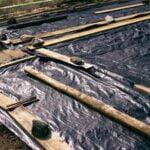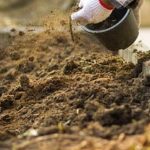Are you considering using pressure treated lumber in your vegetable garden? Many gardeners wonder, “is pressure treated lumber ok for vegetable gardens?” In this article, we will explore the potential risks and benefits of using pressure treated lumber, as well as safe alternatives and guidelines for its use.
Pressure treated lumber is a popular choice for outdoor projects due to its resistance to decay and insects. However, when it comes to using it in vegetable gardens, there are important factors to consider. Understanding what pressure treated lumber is and its potential risks is crucial for making an informed decision about whether or not to use it in your garden.
We will take a closer look at the potential risks of using pressure treated lumber in vegetable gardens, including the chemicals used in the treatment process and their possible impact on soil and plant health. Additionally, we will discuss the benefits of using pressure treated lumber, safe alternatives, and guidelines for its use to help you make an informed decision that aligns with your gardening goals.
What Is Pressure Treated Lumber
Pressure treated lumber is a type of wood that has been infused with preservatives to protect it from rot, decay, and insect damage. This process involves placing the wood in a pressurized tank and forcing chemical preservatives into the wood fibers.
The most common chemicals used in pressure treated lumber are chromated copper arsenate (CCA), alkaline copper quaternary (ACQ), and copper azole (CA-B). This treatment extends the lifespan of the wood, making it an attractive option for outdoor projects, including vegetable gardens.
The use of pressure treated lumber in vegetable gardens is a topic of much debate among gardeners. Many believe that the chemicals used in the treatment process can leach into the soil and be absorbed by plants, potentially posing health risks to those who consume them. However, others argue that when used properly, pressure treated lumber can be a safe and effective material for constructing raised beds and other garden structures.
Despite the potential risks associated with pressure treated lumber, there are also some benefits to using this type of wood in vegetable gardens. These include its durability and resistance to decay, which can prolong the life of garden structures and reduce maintenance costs over time.
When considering whether to use pressure treated lumber in your vegetable garden, it is important to weigh the potential risks against the benefits. It’s also essential to follow guidelines for safe usage and consider alternative materials that may be better suited for your specific needs.
- Use plastic liners or barriers between soil and pressure-treated wood
- Select newer types of treated lumber with lower levels of harmful chemicals
- Consider using naturally resistant woods such as cedar or redwood
Potential Risks of Using Pressure Treated Lumber in Vegetable Gardens
Pressure treated lumber is a common material used for outdoor projects, including building raised beds for vegetable gardens. However, there are potential risks to consider when using pressure treated lumber in vegetable gardens. One of the main concerns is the chemicals used to treat the wood, which can leach into the soil and potentially contaminate the vegetables growing in the garden.
The primary chemical used in pressure treated lumber is chromated copper arsenate (CCA), which is known to contain arsenic. This can be hazardous if ingested, and there is a risk that the arsenic could transfer to the vegetables growing in raised beds made from pressure treated lumber. In addition to arsenic, other chemicals such as creosote and pentachlorophenol may also be used in pressure treated lumber, posing additional health risks.
Studies have shown that there is a possibility of these chemicals leaching into the soil over time, especially in wet conditions. While it is difficult to quantify the exact level of risk posed by using pressure treated lumber in vegetable gardens, it is important for gardeners to weigh these potential hazards against any perceived benefits before deciding whether or not to use this type of material.
| Potential Risks | Chemical Leaching |
|---|---|
| Potential ingestion of hazardous chemicals | Risk of chemicals transferring to vegetables |
| Possibility of arsenic exposure | Leaching into soil over time |
Benefits of Using Pressure Treated Lumber in Vegetable Gardens
Pressure treated lumber offers several benefits that make it an attractive option for use in vegetable gardens. The treatment process involves infusing the wood with chemicals, such as chromated copper arsenate (CCA) or alkaline copper quaternary (ACQ), which are designed to protect the wood from rot, decay, and insect damage. This means that pressure treated lumber is more resistant to deterioration, making it a durable and long-lasting choice for garden beds and structures.
Increased Lifespan
One of the primary benefits of using pressure treated lumber in vegetable gardens is its extended lifespan. The chemicals used in the treatment process help prevent the wood from rotting, decay, and insect infestation, allowing it to withstand moisture and soil exposure without deteriorating quickly. This increased durability can provide gardeners with long-term use of their raised beds, fencing, or other structures made from pressure treated lumber.
Cost-Effectiveness
In comparison to untreated wood or alternative materials like cedar or composite lumber, pressure treated lumber often proves to be a more cost-effective option. Its longevity reduces the need for frequent replacements or repairs, ultimately saving gardeners money over time. With proper maintenance and care, pressure treated lumber can offer a reliable and budget-friendly solution for building and maintaining vegetable gardens.
Versatility
Pressure treated lumber is available in various dimensions and can be easily cut and shaped to fit different garden design needs. It is a versatile material that can be used not only for constructing raised beds but also for creating trellises, fences, garden borders, and other structural elements within a vegetable garden. Its adaptability makes it a convenient choice for implementing different gardening layouts and features.
Safe Alternatives to Pressure Treated Lumber
When it comes to building raised beds for your vegetable garden, it is important to consider the safety of the materials you use. While pressure treated lumber is a common choice due to its durability and resistance to decay, there are alternative options that can be just as effective and safer for growing vegetables.
Safe alternatives to pressure treated lumber for vegetable gardens include:
1. Cedar: Cedar is naturally resistant to rot, decay, and insect damage, making it an excellent choice for raised beds. It also has a natural beauty that can enhance the aesthetic appeal of your garden.
2. Redwood: Redwood is another durable and naturally rot-resistant wood that is often used in outdoor furniture and structures. It may be more expensive than other options, but its longevity and sustainability make it a great alternative to pressure treated lumber.
3. Composite lumber: Composite lumber is made from a combination of wood fibers and recycled plastic, offering the durability of traditional lumber without the risk of chemical leaching. It also requires minimal maintenance, making it a low-maintenance option for long-lasting vegetable garden beds.
Using these safe alternatives can provide peace of mind knowing that your vegetable garden is not being exposed to harmful chemicals commonly found in pressure treated lumber. By choosing natural or composite materials, you can create a healthy environment for your plants to thrive while minimizing any potential risks associated with pressure treated lumber.
Ultimately, when deciding on the best material for your vegetable garden beds, it is important to prioritize safety and sustainability. While pressure treated lumber may have its benefits in terms of durability, there are safe alternatives available that offer similar advantages without compromising the well-being of your plants or the environment.
Guidelines for Using Pressure Treated Lumber in Vegetable Gardens
When it comes to using pressure treated lumber in vegetable gardens, there are some important guidelines to keep in mind. While pressure treated lumber can provide durability and longevity to raised garden beds, it is important to use this type of material safely and responsibly.
Choose the Right Type of Pressure Treated Lumber
When selecting pressure treated lumber for your vegetable garden, it is essential to choose the right type. Look for lumber that is treated with ACQ (alkaline copper quaternary) or copper azole, as these treatments are considered safer for use in vegetable gardens. Avoid lumber treated with CCA (chromated copper arsenate), as this type contains arsenic which can leach into the soil and potentially harm your plants.
Use a Barrier
To further minimize any potential risks of using pressure treated lumber in your vegetable garden, it is recommended to create a barrier between the wood and the soil. This can be achieved by lining the interior of the raised bed with heavy-duty plastic sheeting before adding the soil. The barrier will help prevent any chemicals from leaching into the soil and coming into contact with your vegetables.
Maintain Good Practices
Regular maintenance of pressure treated lumber in your vegetable garden is crucial to ensure its safety. Apply a sealant or stain to the wood annually to reduce any potential leaching of chemicals into the soil. Monitoring the condition of the wood and replacing any damaged pieces when necessary is also important for maintaining a safe environment for growing vegetables. By following these guidelines, you can safely use pressure treated lumber in your vegetable garden while minimizing potential risks.
Conclusion
In conclusion, the use of pressure treated lumber in vegetable gardens is a topic of much debate and consideration. While pressure treated lumber may provide durability and longevity to garden structures, there are potential risks associated with using this type of wood in close proximity to edible plants. The chemicals used to treat the wood, such as arsenic, chromium, and copper, can leach into the soil over time and be absorbed by the vegetables.
While some experts argue that the levels of these chemicals are minimal and pose little risk to human health, others advocate for using safer alternatives to pressure treated lumber in vegetable gardens. In any case, it is essential for gardeners to weigh the potential risks and benefits before making a decision.
Ultimately, each gardener must make an informed decision based on their specific circumstances and priorities. Whether one chooses to use pressure treated lumber or explore safe alternatives, it is crucial to follow guidelines for safely using pressure treated wood in vegetable gardens. Regular monitoring of the soil, proper handling of the wood, and incorporating safe practices can help mitigate any potential risks that is pressure treated lumber ok for vegetable gardens may pose.
Frequently Asked Questions
Is It Safe to Use Pressure Treated Wood in a Vegetable Garden?
Using pressure treated wood in a vegetable garden can be a topic of debate. While the chemicals used to treat the wood can potentially leach into the soil, studies have shown that the risk to human health from using pressure treated wood in vegetable gardens is low.
However, it’s still important to take precautions such as using a barrier between the wood and soil.
Is Home Depot Pressure Treated Wood Safe for Vegetable Gardens?
Home Depot’s pressure treated wood is generally considered safe for use in vegetable gardens. The chemicals used in the treatment process have evolved over time, and currently, most pressure treated wood sold at Home Depot and other retailers use safer compounds that are less likely to leach into the soil.
It’s always best to check with a store representative or do some research on specific products before purchasing.
What Type of Wood Is Safe for Vegetable Garden?
When it comes to choosing safe wood for a vegetable garden, cedar and redwood are popular choices. These types of wood naturally contain oils that help resist rot, decay, and insect infestation without needing chemical treatment. Cedar and redwood are also known for their durability and can last many years in outdoor conditions without negatively impacting the plants growing nearby.

If you’re looking to get into vegetable gardening, or are just looking for some tips on how to make your current garden better, then you’ve come to the right place! My name is Ethel and I have been gardening for years. In this blog, I’m going to share with you some of my best tips on how to create a successful vegetable garden.





